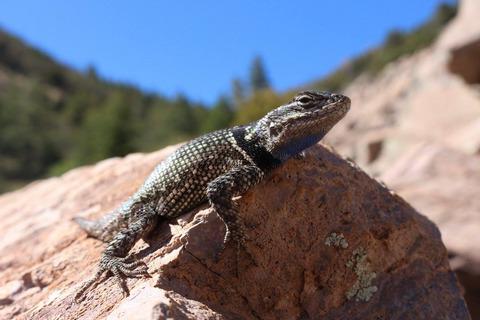Our official English website, www.x-mol.net, welcomes your
feedback! (Note: you will need to create a separate account there.)
Changes in thermal quality of the environment along an elevational gradient affect investment in thermoregulation by Yarrow’s spiny lizards
Journal of Zoology ( IF 1.9 ) Pub Date : 2020-08-28 , DOI: 10.1111/jzo.12818 A.H. Lymburner 1 , G. Blouin‐Demers 1
Journal of Zoology ( IF 1.9 ) Pub Date : 2020-08-28 , DOI: 10.1111/jzo.12818 A.H. Lymburner 1 , G. Blouin‐Demers 1
Affiliation

|
Body temperature affects physiological processes and, consequently, is assumed to have a large impact on fitness. Lizards need to thermoregulate behaviourally to maintain their body temperature within a range that maximizes performance, but there are costs associated with thermoregulation. The thermal quality of an environment directly affects the amount of time and energy that must be invested by an individual to maintain an optimal body temperature for performance; time and energy are major costs of thermoregulation. According to Huey and Slatkin’s (Q. Rev. Biol. 1976, 363) cost–benefit model of thermoregulation, lizards should only thermoregulate when the benefits outweigh the costs. Thus, in habitats of poor thermal quality, lizards should invest less into thermoregulation. We tested the hypothesis that the thermal quality of an environment dictates investment in thermoregulation across an elevational gradient. Increases in elevation are accompanied by decreases in temperature and therefore thermal quality. We recorded body temperatures of Yarrow’s spiny lizards (Sceloporus jarrovii) at ten talus slopes along an elevational gradient of over 1000 m. We found a significant positive relationship between elevation and effectiveness of thermoregulation, opposite to the prediction of the cost–benefit model of thermoregulation. This suggests that the disadvantages of thermoconformity may be greater than the costs of thermoregulating as habitats become more thermally challenging.
中文翻译:

沿海拔梯度变化的环境热质量会影响Yarrow的有刺蜥蜴对温度调节的投资
体温影响生理过程,因此,认为对体能有很大影响。蜥蜴需要进行体温调节,以将其体温维持在使性能最大化的范围内,但是温度调节会带来成本。环境的热质量直接影响个人为了维持最佳体温才能表现所需的时间和精力。时间和精力是温度调节的主要成本。根据Huey和Slatkin的温度调节的成本效益模型(Q. Rev. Biol。1976,363),蜥蜴只能在收益大于成本时才进行温度调节。因此,在热质量差的栖息地,蜥蜴应减少对温度调节的投入。我们检验了以下假设:环境的热质量决定了跨海拔梯度进行温度调节的投资。海拔升高会伴随温度降低,进而导致热质量降低。我们记录了雅罗氏多刺蜥蜴的体温(在10个距骨斜坡上的Sceloporus jarrovii)海拔超过1000 m。我们发现温度升高与温度调节的有效性之间存在显着的正相关关系,与温度调节的成本效益模型的预测相反。这表明,随着生境变得更具热挑战性,热整合的弊端可能大于热调节的成本。
更新日期:2020-10-05
中文翻译:

沿海拔梯度变化的环境热质量会影响Yarrow的有刺蜥蜴对温度调节的投资
体温影响生理过程,因此,认为对体能有很大影响。蜥蜴需要进行体温调节,以将其体温维持在使性能最大化的范围内,但是温度调节会带来成本。环境的热质量直接影响个人为了维持最佳体温才能表现所需的时间和精力。时间和精力是温度调节的主要成本。根据Huey和Slatkin的温度调节的成本效益模型(Q. Rev. Biol。1976,363),蜥蜴只能在收益大于成本时才进行温度调节。因此,在热质量差的栖息地,蜥蜴应减少对温度调节的投入。我们检验了以下假设:环境的热质量决定了跨海拔梯度进行温度调节的投资。海拔升高会伴随温度降低,进而导致热质量降低。我们记录了雅罗氏多刺蜥蜴的体温(在10个距骨斜坡上的Sceloporus jarrovii)海拔超过1000 m。我们发现温度升高与温度调节的有效性之间存在显着的正相关关系,与温度调节的成本效益模型的预测相反。这表明,随着生境变得更具热挑战性,热整合的弊端可能大于热调节的成本。











































 京公网安备 11010802027423号
京公网安备 11010802027423号